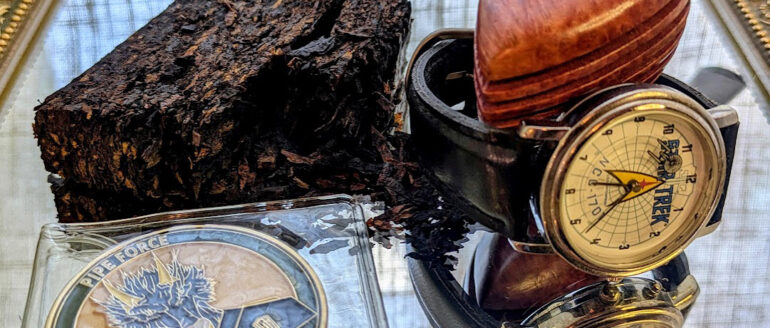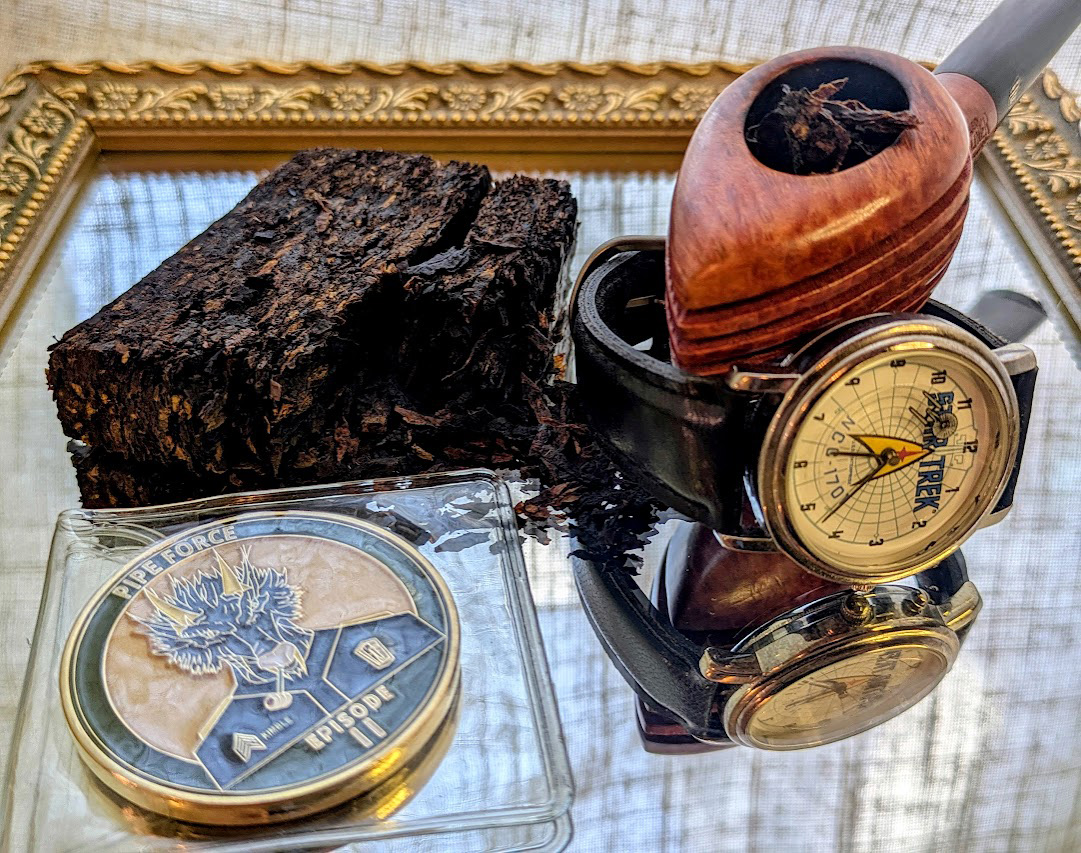
We’re in the dog days of summer, and in the heat and humidity I find my palate tends to become as erratic as the extreme weather. To be more precise, my entire biochemistry is busily making the continual adjustments that keep this finely-tuned machine old jalopy of a body in top form hobbling along, and my taste buds are a good indicator that the system is preoccupied with regulating itself. Therefore it’s no surprise that McCranie’s Roanoke, the tobacco that I’d been favoring since the winter months and regularly returning to between other review blends, just wasn’t hitting the spot anymore. We live in fortunate times that present no shortage of novel and interesting blends to try, so some speculation toward new flavors is in order. This month’s spotlight will thus fall on a couple of summer sequels, of a sort: first, the latest installment of Per Jensen’s Pipe Force line, Episode II to be exact; second, a new incarnation of Seattle Pipe Club’s Hogshead, this time with a bourbon barrel-aged twist.
Much like The Empire Strikes Back improved on the previous film in that series, Episode II is a generational improvement on the English profile offered in Episode I. To my personal taste, while I enjoyed Episode I quite a bit, it didn’t have a definable hook for me; this iteration of a similar ingredient list hits much closer to the mark. Here again it is a Latakia-forward mixture presented with Katerini concoctions and stoved tobaccos, but with more variety and, for my money, more interest. From the tin:
A mellow, sweet mixture of Bright, Red, and Stoved Virginia offers the exceptional base for smokey Latakia, floral Kentucky, spice of Stoved Katerini and the ambrosial berry and spice of Katerini Perique. The result is a harmony of flavor in perfect balance.
The bouquet in the tin is tart, heathery, and leathery, in equal proportion. The aroma is dry and smoky with clear clay overtones and, as advertised, faint berry notes from the tin. In the bowl the sweetness sneaks in immediately, displaying a wonderful synergy between the Katerini Perique (Periquini? Katerique?) and the Virginias, offering a flavor unique and quite apart from the usual raisiny range commonly found in Virginia / Perique meldings. Conversely, the Latakia’s smoky, burning-rubber character is also influenced by the Katerini, directing it toward a very pinyon-esque range of aroma that lingers distinctly the room note afterward. Speaking of room note, it can become rather tart after repeated bowls—advise any expected visitors that no, there isn’t a diesel fire in your house, you’re just savoring your time with a new blend.
It’s offered as a tight 50g crumble cake, easily broken apart for preparation. As if it needed any more curb appeal, every 10th tin of the series includes a challenge coin featuring the tin’s artwork inside, and this was a lucky tin. It’s a great way to have fun with the series, makes a great addition to the random tchotchkes adorning one’s desk, and serves as a very tactile fidget toy that doubles as a brand reminder—is it time to stock up again? In my testing it seemed at its best in a wider, shallower bowl; the ember was easier to tend, breath pacing allowed a fuller flavor, and it didn’t veer too strongly to the tarry tones that Lat can have. Of the flavors there were many—often varying from bowl to bowl, and very dependent on accompanying beverage or previous meal, it seems. It’s an unfocused blend, but not to its detriment in this regard; it had a very consistent overall tone, with each bowl eliciting some new and interesting flavor moments—my notes are all over the spectrum, with observations like popcorn, maple bacon, charred cardboard, the aforementioned diesel fumes, burnt beef ends, dried silage, musky oak, swamp water (peaty!), and dried vodka. Appreciably, those who enjoy Latakia will read all these descriptors and understand that none of them are negative. It was so fun to keep chasing these disparate flavors that I did incur some mouth fatigue, just this side of bite, after rapidly repeated bowls. Slow smoking and pacing are advised, as the nicotine was mild enough to not discourage such practice.

Overall, Episode II is a blend with so many interesting things going on that it warrants another taste after it has some age on it. My hope is that with some time in the tin, the Latakia notes will tone down on the dryness and the Viriginia / Katerique sweetness will amplify, with all the other cacophonous notes finding their home in the in-between spaces comfortably. Per’s experiments with these new treatments of old leaf are yielding remarkable results, and I look forward to seeing them in more blends in the future, and indeed more innovation of this sort in the tobacco world in general. Tasting something so similar, yet so slightly different, from what’s been available before is what this market needs.
Seattle Pipe Club Hogshead: Bourbon Barrel Aged Review
Our second summer blockbuster is SPC’s Hogshead: Bourbon Barrel Aged. Somewhat akin to that other summer blockbuster, Deadpool & Wolverine, this one is a cut above its predecessor. Thank you ladies and gentlemen, I’ll be here all week, tip your waitress…
Vintage Virginia tobacco cultivated from around the world aged in a bourbon barrel for 30 days. The tobacco is then pressed and cut for a unique and one of a kind smoking experience.
Well at least they didn’t prattle on with the ad copy and let the blend speak for itself. Veering a hard left from the boisterous melange of the Pipe Force, this iteration of Hogshead is a dead simple straight Virginia blend of the same 10-year-old red & orange used in the prior, this time presented in thickly-sliced pressed flakes, aged in bourbon barrels. Deceptively simple, that is—the flavors of this blend are robust and varied, punching above their weight class for being confined to the comparatively narrow range of “just Virginia”.
The first thing to note is that the tin bouquet is soulfully reminiscent of a bygone blend that graced us for far too brief a moment: McClelland’s Stave-Aged 35. Top notes of bright tart cherry and raisin, the distinct tannic tang of oak char, the undercurrent of fresh-cut hay and baked croissant…my mouth is watering just from giving it a moment in the air before packing my bowl. Unsurprising, for obvious reasons, but the comparison doesn’t stop there. Looking back in old tasting notebooks, this blend hits nearly every note the erstwhile McClelland did, with the only significant difference—aside from the trademark ketchup aroma, Lord how I miss it—being that the McClelland effort offered a smoother smoke, especially after repeated bowls. While I wouldn’t say this blend bites, an aggressive over-smoker (such as myself) may fall afoul of their tongue on this one—easily remedied by mindful smoking, frequent palate washing, and pacing out your bowls.
Having the globally-positioned resources that parent company MacBaren has at its disposal makes gems like this club-branded blend possible. The blend utilizes African, Brazilian, and American leaf (and presumably American barrels), purportedly already with a good deal of age on it, to the tune of a decade. As with the McClelland blend, the flavor and aroma imparted by the bourbon cask just fits perfectly with a smooth and balanced Virginia. Evidenced from the tin aroma to the top light and through to the heel and room note, these are flavors that belong together like peanut butter and jelly. Even while working within the confines of a single-variety blend, so much subtle interest and nuance develops with the flavor from start to finish that it never loses the thread. The final lesson imparted from the McClelland blend is that HH:BBA is definitely worth socking away a few tins in the cellar, as it’s only going to get better—and likely won’t be around forever.
















